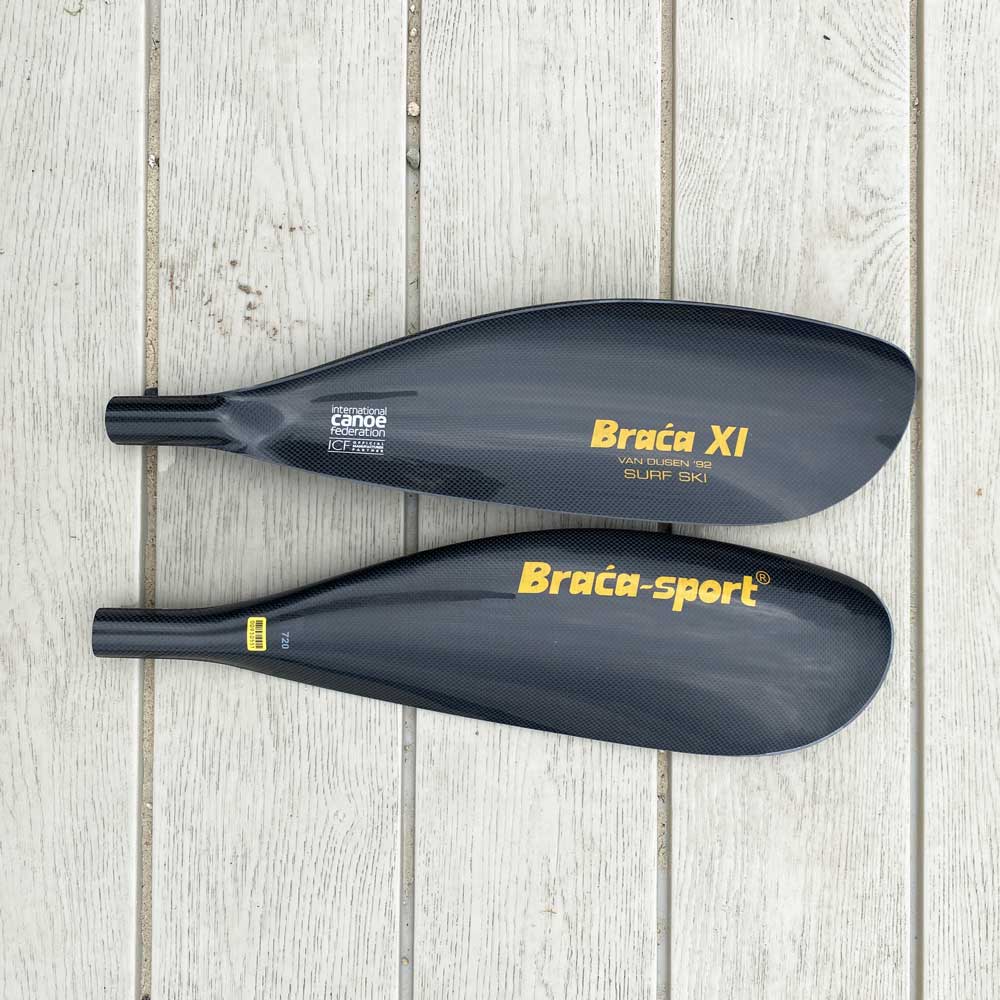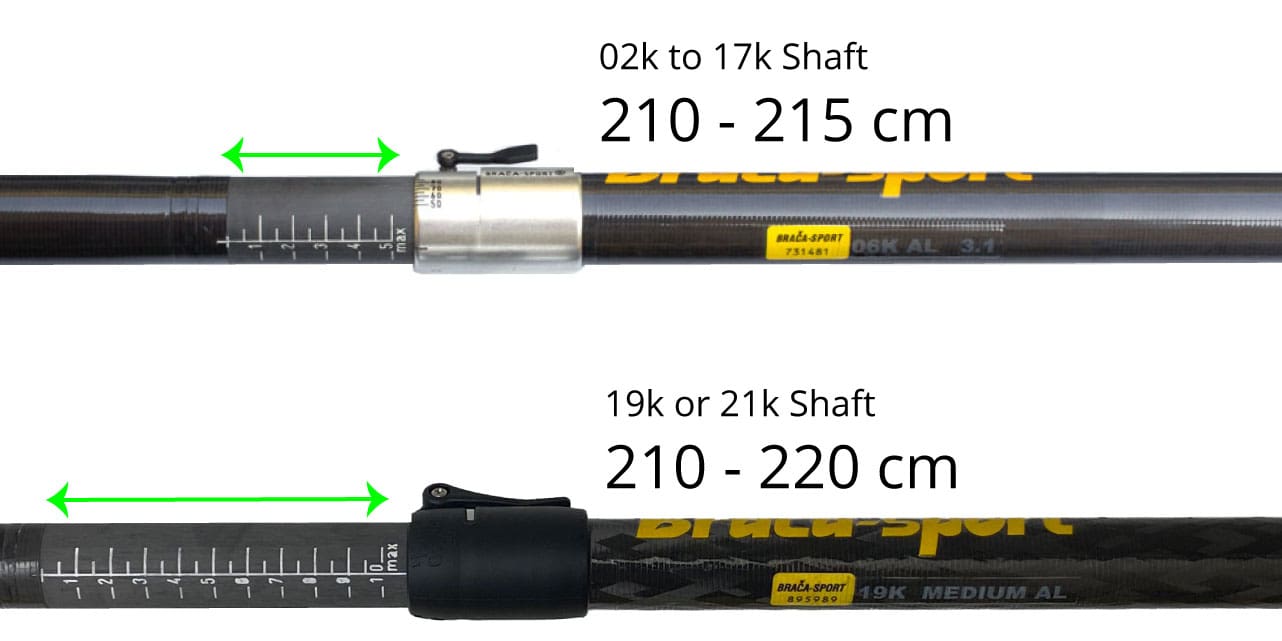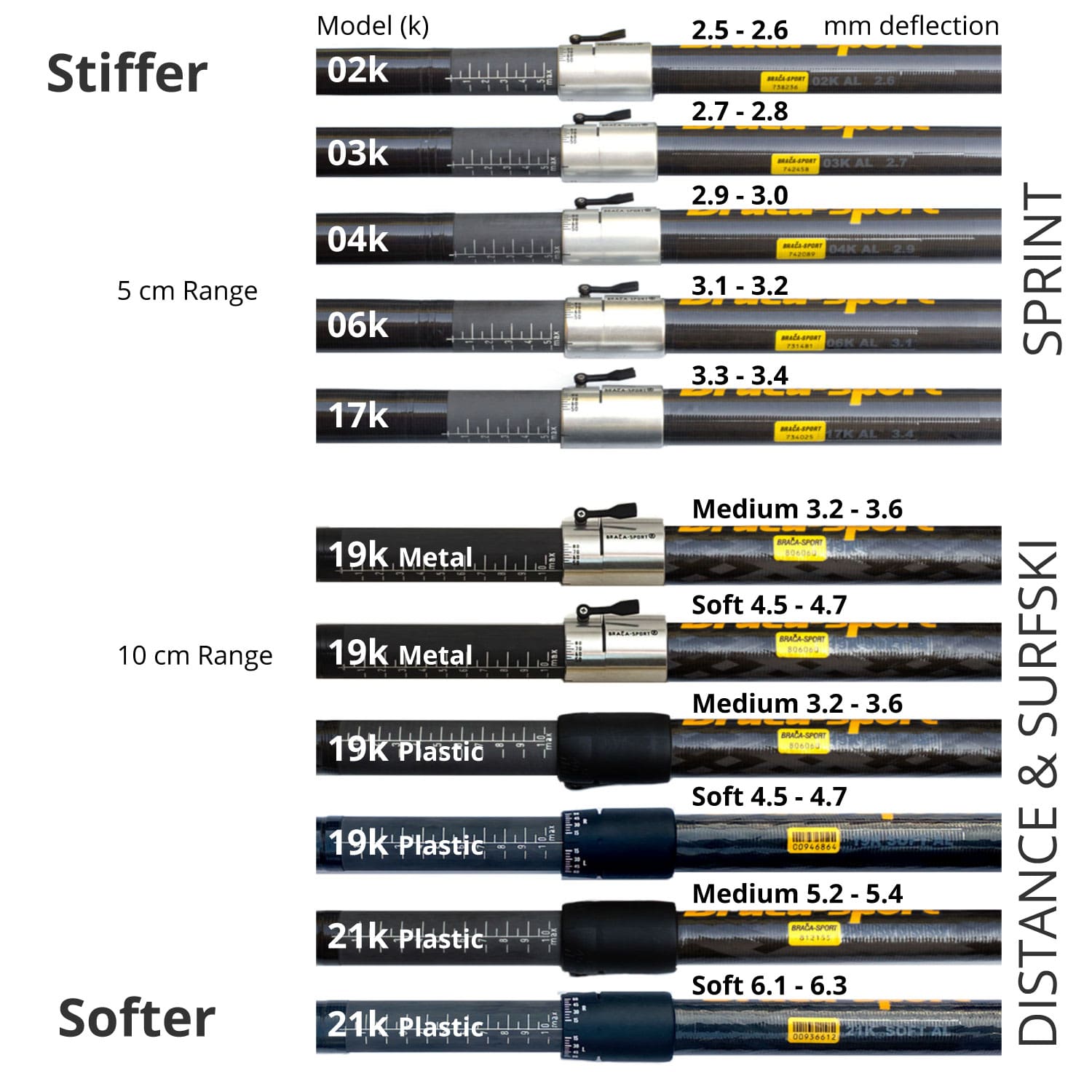Braca-sport Wing Paddles Selection
To help answer the question: What should I get for my first wing paddle?
Braca paddles are meticulously designed and manufactured to deliver exceptional performance for all athletes. Given the diverse range of athletes and environments, there are numerous ways to customize the paddle to create an ideal and personalized experience.
Selecting a Blade Shape
Braca offers the most diverse selection of wing paddle designs. Braca kayak paddle designs are avilable in a dozen different shapes, each with their specific characteristics. With four distinct design families, the top two are the most widely used.
- Tear Drop | Classic wing shape with mild twist
- Extreme Tear Drop | Wing with more extreme twist
- Parallel Edge | Leading and trailing edges run parallel
- Hybrid Fusion | Hybrid of features
We recommend these two paddles, our top sellers and all of their options are in stock:
Braca IV – a teardrop wing paddle with slight twist
The Braca IV is one of the most popular paddle designs in the world. It is the original wing paddle developed first by Braca. Favored by many World and Olympian sprinters this is a solid choice. The Braca IV shape offers blade sizes from 610 to 765 and then the Braca I, the same design but bigger, from 775 to a whopping 840. The Braca IV also has a 60% carbon option that makes a great wing paddle for youth, masters, marathon due to the more forgiving performance of 60% carbon. The Braca IV Carbon 60 is also priced less than full carbon paddles and is a club team favorite.
Braca XI Van Dusen – a teardrop wing paddle with extreme twist
The Braca XI is equally popular and in use at high levels of competition worldwide. The Braca XI Van Dusen is an extreme twist paddle, while that sounds extreme it actually a smooth and efficient paddle. It is designed to provide smooth power at varied cadences. It plants solidly and performs for athletes at all levels, including the very top. The Braca XI Van Dusen ’92 is a great shape to take a look at, it’s one of our most popular paddles for its power at varied cadences. A solid performer that uses rotation to great advantage. Designed by Ted Van Dusen in ’92 and licensed by Braca.
Selecting a Construction
Braca provides a wide range of constructions, allowing you to customize your paddle according to your conditions. Surfski blades, known for their stiffness, lightness, and strength, are recommended for most paddlers, including those on flatwater. For specific conditions such as rocky or shallow waters, the Marathon and Down River constructions are ideal.
Possible blade constructions are:
- Standard: Our regular 100% carbon construction paddle
- Surfski: Reinforced for reverse forces of bracing and current in all waters, stiff and light
- Extra Light: A lighter, stiffer version approx 20 to 100 g lighter than a standard
- Carbon 60: Durable, slightly heavier blade at lower price point for club, masters, marathon, youth
- Marathon: Kevlar tips for durability for rugged conditions
- Down River: edge of the blade is reinforced with metal for severe conditions
- Soft: A more forgiving performance blade often used for stress reduction
Extra Light and Surfski are the most popular choices. Surfski is not just for ocean paddling.
Selecting a Blade Size
Several factors go into selecting a blade size.
- Athlete Size: The physical dimensions of the paddler, including height and strength, impact the ideal blade size. Larger athletes may benefit from larger blades to harness more power, while smaller athletes might find smaller blades more manageable.
- Distance: The distance you plan to cover affects blade size. For longer distances, a balance between efficiency and reduced fatigue is essential. Smaller blades may be favored for endurance paddling.
- Stroke Rate: Blade size is directly connected to stroke rate. Larger blades can provide more power but may result in a slower stroke rate. Athletes often choose a size that aligns with their preferred stroke rate and paddling style.
- Environment: The type of water and environmental conditions also play a role. In windy or choppy conditions, a smaller blade may be advantageous for stability and control, whereas larger blades can be more suitable for calm waters.
- Injury Prevention: The risk of injury is a crucial consideration. Using a blade size that allows for a natural and comfortable paddling motion can contribute to injury prevention. Athletes recovering from specific injuries may benefit from adjusting blade size to reduce strain.
As an example these are the Braca XI blade sizes: 675 705 720 735 750 760 775 795 805 815.
Selecting Paddle Length
Your paddle has a generous 10 cm adjustment range with the 19k or 21k shaft, allowing you to easily set it to a shorter or longer length as needed.
More info Coming Soon
Selecting A Shaft
Braca manufactures their own shafts and they are designed and woven to provide ideal flex characteristics. You can pick a specific shaft stiffness and custom paddle length, adjustable to 5 or 10 cm. In general the larger the blade the stiffer the shaft. Sprinter shafts have metal connectors and all others have plastic.
Braca shafts are circular in shape with the 21K having a slighly smaller diameter. Braca 19K and 21K have a subtle woven texture making it easy to grip your paddle without adding tape if that’s your preference.
Each paddle has a reduced selection of available shafts. Your paddle selection will indicate available shafts, for example a large Braca XI sprint blade will only show the stiffest sprinter shafts as options. The recommended approach is to use stiff, well-made blades (such as Braca!) and accomodate flexibility through the shaft.
Shaft model numbers(K) = mm of deflection
Least Flexible
- 01K: Stiffness = 2.3 – 2.4 — Sprinter
- 02K: Stiffness = 2.5 – 2.6 — Sprinter
- 03K: Stiffness = 2.7 – 2.8 — Sprinter
- 04K: Stiffness = 2.9 – 3.0 — Sprinter
- 06K: Stiffness = 3.1 – 3.2 — Sprinter
- 17K: Stiffness = 3.3 – 3.4 — Sprint, Marathon, Flatwater Fitness, Mild Ocean
- 18K: Stiffness = 3.2 – 3.5 — Down River paddles use the 18K shaft
- 19K: Stiffness = Medium 3.2 – 3.6 — Sprint, Marathon, Fitness, Surfski
- 19K: Sitffness = Soft 4.5 – 4.7 — Sprint, Marathon, Fitness, Surfski
- 21K: Stiffness = Medium 5.2 – 5.4 — Fitness, Surfski
- 21K: Stiffness = Soft 6.1 – 6.3 — Fitness, Surfski
Most Flexible
Some general guidelines:
Our most popular configuration is the 19K with the 21k a close second, racing, marathon, surfski, fitness training.
The majority of USA paddlers use flexible options like 19K and 21K, or if prefer stiffer alternatives then the 06K and 17K
Use a softer shaft for surfski, the 19K or 21K, with plastic connectors for durability in salt water.
For marathon, long distance competitors, we recommend the 19K
For sprinters, with their large blades, use the stiffest shafts, pros use most stiff, 02K, 03K, 04K.
All youth paddles have specifically designed shafts with more flex similar to Braca IV carbon 60 10K shaft
Down River paddles use the 18K shaft only, specifically designed for downriver conditions. Marathon blades could use any but consider softer options.
Preventing an injury? Go as soft as possible and also consider softer blades such as Carbon 60 or Soft Blade
Shaft Stiffness Choice by Sport
Sprinters – 02k to 17k
Surfski – 19k, 21k — always with plastic locker for salt water
Marathon, Distance – 19k
Fitness, Training – 17k, 19k, 21k — mostly 19k with plastic locker
Downriver – Down River blades use an 18K shaft with metal locker, specifically designed for down river conditions.
Selecting Paddle Angle (Feather)
When ordering an adjustable paddle you do not need to pick a feather angle as all adjustable paddles offer flexibility, allowing you to set the feather angle anywhere from 0 to 90 degrees. Adjusting the paddle feather angle is easily achieved by loosening the connector and rotating the shaft according to the marks. The paddle feather angle is a key topic of discussion among users! It is generally determined by the angle at which your paddle enters the water; a higher water entry angle indicates a higher paddle feather angle setting. Surfskiers often prefer lower feather angles, with some opting for 0 degrees. K1 sprinters generally maintain a feather angle of around 60 degrees. If you order a one-piece paddle (available upon request) you will need to select your paddle feather angle as it will be a fixed-length one-piece shaft with no connector.
High twist paddles such as Braca XI are designed such that the paddle angle should not be set above 60 degrees.






